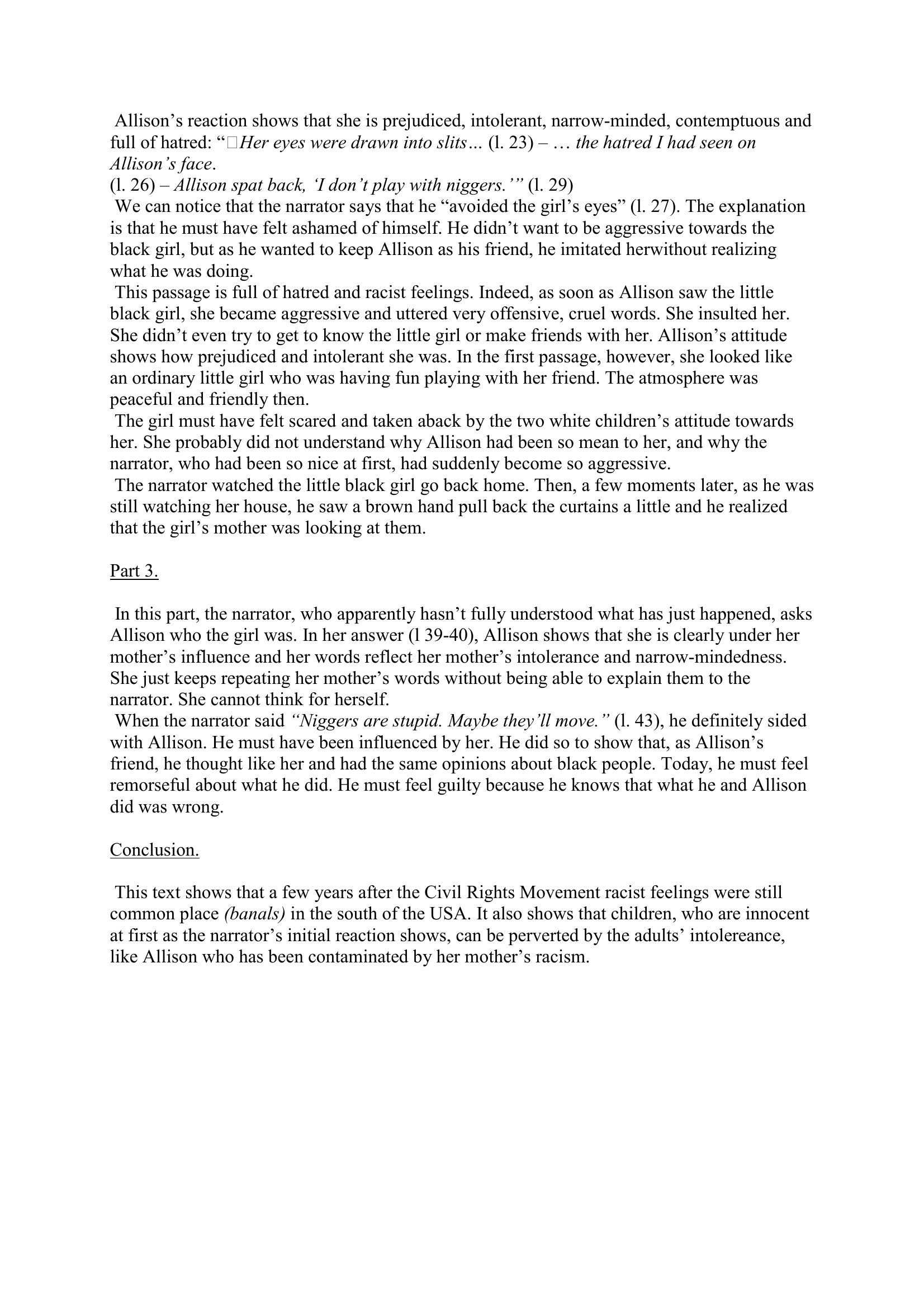THE NEW GIRL
Publié le 01/05/2012

Extrait du document
Nature of the text.
This text is an autobiographical short story written by Marc Mitchell and published in True Tales of American Life, a collection of short stories.
Summary (résumé).
The scene takes place in Alabama, a State located in the South of the USA, in the 1970s. The story tells an episode of the author’s childhood, that is to say his encounter (rencontre) with a young black girl. The characters are the narrator, his friend Allison, and a little black girl whose name is not mentioned. The text shows how the little black girl, who has just moved in, is rejected by the narrator and Allison.
Organisation of the text.
This text can be divided into three parts: first the circumstances and events until the narrator’s silent contact with the black girl (l. 1-15), then Allison’s reaction towards this girl (l. 16-36), and finally the two white children’s reactions after the black girl has gone away (l. 37-45).
«
Allison’s reaction shows that she is prejudiced, intolerant, narrow-minded, contemptuous and
full of hatred: “ Her eyes were drawn into slits… (l.
23) – … the hatred I had seen on
Allison’s face .
(l.
26) – Allison spat back, ‘I don’t play with niggers.’” (l.
29)
We can notice that the narrator says that he “avoided the girl’s eyes” (l.
27).
The explanation
is that he must have felt ashamed of himself.
He didn’t want to be aggressive towards the
black girl, but as he wanted to keep Allison as his friend, he imitated herwithout realizing
what he was doing.
This passage is full of hatred and racist feelings.
Indeed, as soon as Allison saw the little
black girl, she became aggressive and uttered very offensive, cruel words.
She insulted her.
She didn’t even try to get to know the little girl or make friends with her.
Allison’s attitude
shows how prejudiced and intolerant she was.
In the first passage, however, she looked like
an ordinary little girl who was having fun playing with her friend.
The atmosphere was
peaceful and friendly then.
The girl must have felt scared and taken aback by the two white children’s attitude towards
her.
She probably did not understand why Allison had been so mean to her, and why the
narrator, who had been so nice at first, had suddenly become so aggressive.
The narrator watched the little black girl go back home.
Then, a few moments later, as he was
still watching her house, he saw a brown hand pull back the curtains a little and he realized
that the girl’s mother was looking at them.
Part 3.
In this part, the narrator, who apparently hasn’t fully understood what has just happened, asks
Allison who the girl was.
In her answer (l 39-40), Allison shows that she is clearly under her
mother’s influence and her words reflect her mother’s intolerance and narrow-mindedness.
She just keeps repeating her mother’s words without being able to explain them to the
narrator.
She cannot think for herself.
When the narrator said “Niggers are stupid.
Maybe they’ll move.” (l.
43), he definitely sided
with Allison.
He must have been influenced by her.
He did so to show that, as Allison’s
friend, he thought like her and had the same opinions about black people.
Today, he must feel
remorseful about what he did.
He must feel guilty because he knows that what he and Allison
did was wrong.
Conclusion.
This text shows that a few years after the Civil Rights Movement racist feelings were still
common place (banals) in the south of the USA.
It also shows that children, who are innocent
at first as the narrator’s initial reaction shows, can be perverted by the adults’ intolereance,
like Allison who has been contaminated by her mother’s racism..
»
↓↓↓ APERÇU DU DOCUMENT ↓↓↓
Liens utiles
- The New Girl
- Fiche de lecture sur le chapitre 11: The Greek of the New Testament, par Mark Janse, sur la section IV de l’ouvrage, intitulé: Ancient Greek: structure and change, pages 646-653.
- What are the consequences of the discoveries of new plants by Europeans ?
- FILLE PERDUE (La) [The Lost Girl]. David Herbert Lawrence (résumé)
- The Girl from Ipanema - analyse de l'oeuvre.



















